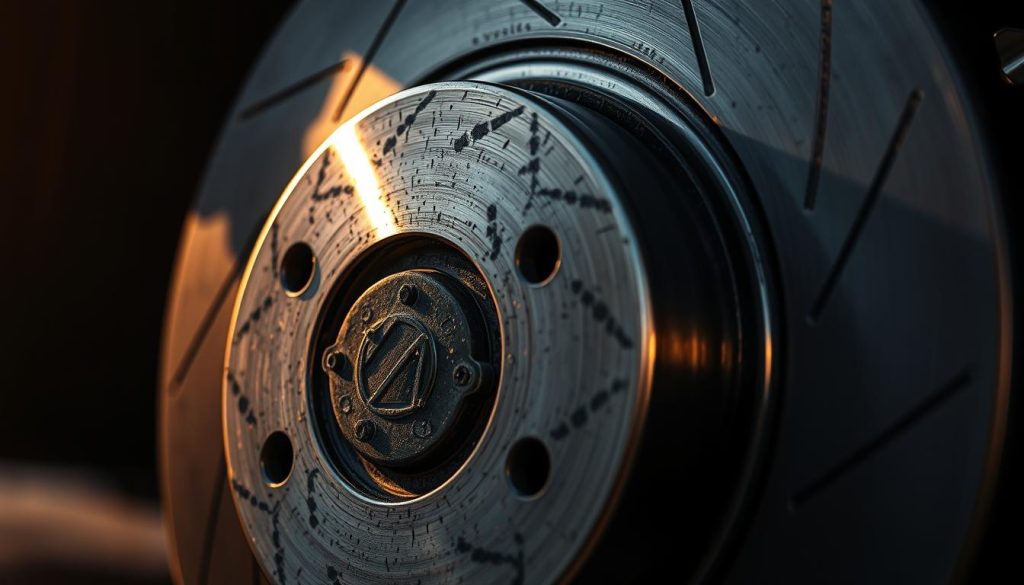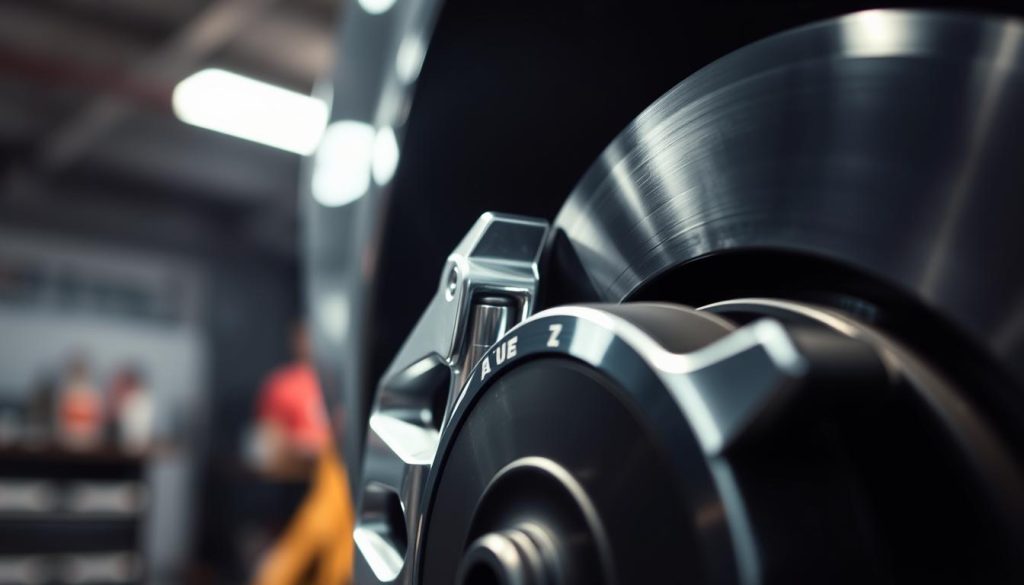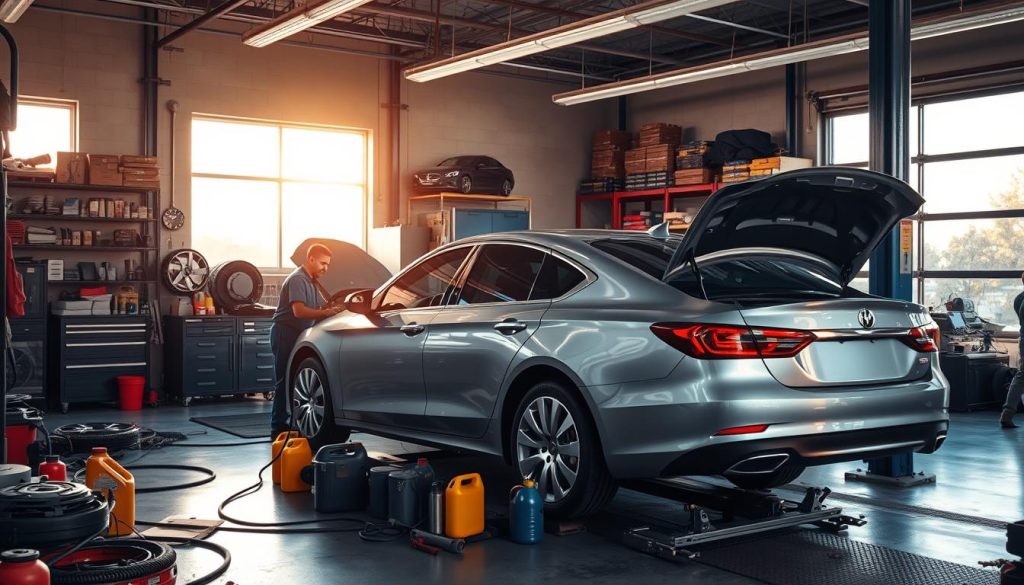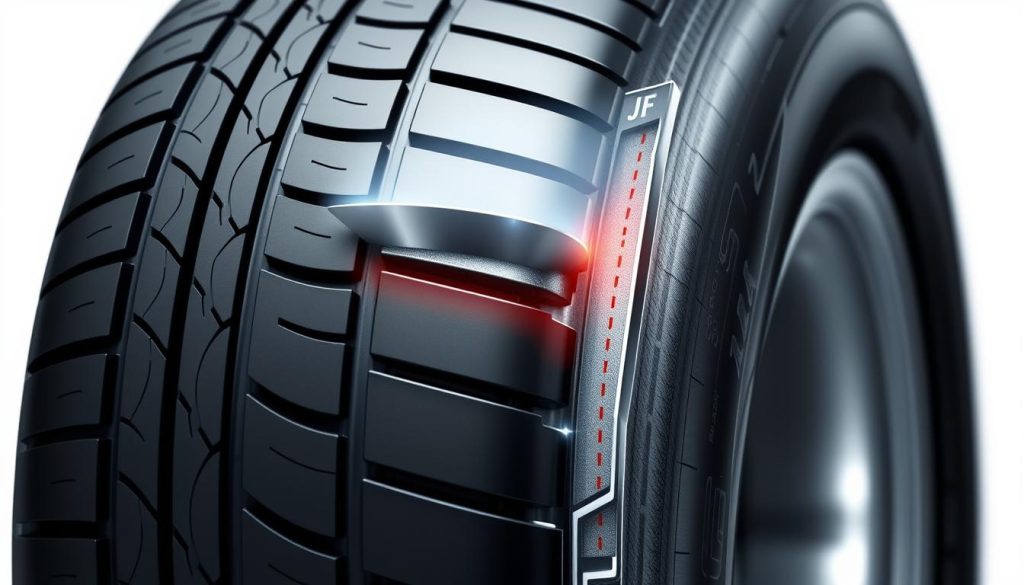If your car’s controls shake or pull unexpectedly, it’s more than just an annoyance—it’s a red flag. These sensations often signal problems with critical components like tires, brakes, or suspension systems. Ignoring them could lead to expensive repairs down the road.
At Heaven Automotive, we’ve seen how minor issues evolve into major headaches when drivers delay action. For example, uneven tire wear might start as a subtle wobble but eventually strain your suspension. Early detection saves time, money, and keeps you safe on the road.
Diagnosing these problems requires expertise. Our technicians use advanced tools to pinpoint whether misaligned wheels, worn brake rotors, or unbalanced tires are to blame. Each component interacts with others, so a thorough inspection is key.
In this guide, we’ll break down common reasons behind these warning signs and share proven solutions. Whether it’s a quick tire rotation or brake repair, addressing the root cause restores smooth driving. Let’s dive into the details—and remember, Heaven Automotive is here to resolve any issues efficiently.
Key Takeaways
- Shaking or pulling sensations often indicate tire, brake, or suspension problems.
- Early intervention prevents minor issues from becoming costly repairs.
- Professional diagnostics ensure accurate identification of underlying causes.
- Multiple vehicle systems can contribute to instability while driving.
- Expert repairs restore safety and performance to your car.
Introduction to Steering Wheel Vibration
Unusual movements in your car’s controls aren’t just distracting—they’re urgent warnings. When the wheel trembles, jerks, or drifts without input, it points to mechanical issues needing expert care. At Heaven Automotive, we’ve resolved hundreds of these cases, from minor imbalances to critical system failures.
This problem typically starts as a faint wobble at certain speeds. During braking, it might intensify into pronounced shuddering. Accelerating could trigger side-to-side sway, while highway driving may cause persistent trembling. Each pattern helps our technicians identify the root cause.
Drivers often describe three main sensations:
- Subtle pulses in the wheel at low speeds
- Forceful oscillations during turns or stops
- Persistent tugging toward one side
Ignoring these signs risks more than discomfort. Worn parts can fail suddenly, reducing control during crucial moments. Most cases involve tire imbalances, brake wear, or suspension damage—systems that demand precise adjustments.
Our team uses vibration analysis tools and road tests to pinpoint issues efficiently. Whether it’s a warped rotor or loose component, we restore stability without guesswork. Don’t gamble with unpredictable handling—schedule a diagnostic at our shop today.
Understanding the Mechanics Behind Steering Wheel Vibration
When your car’s controls transmit unusual sensations, it’s your vehicle communicating mechanical stress. These disturbances occur when imbalances or damage in critical parts disrupt smooth operation. At Heaven Automotive, we decode these signals by examining how energy travels through interconnected systems.
What Causes These Disturbances?
Mechanical imbalances in rotating parts—like tires or brake rotors—create rhythmic forces. These forces travel through suspension linkages and steering columns, amplifying as they reach the driver’s hands. Even minor imperfections, such as a bent wheel or worn joint, can generate noticeable feedback.
Essential Parts for Smooth Operation
Four core systems work together to maintain stability:
- Tires and wheels: Proper balance ensures even rotation
- Suspension: Bushings and joints absorb road impacts
- Braking system: Warped rotors disrupt smooth stops
- Steering linkage: Tight connections prevent play
When one component fails, it stresses adjacent parts. For example, an unbalanced tire strains wheel bearings, while worn ball joints allow excessive movement. Our technicians trace these relationships using specialized tools, identifying whether issues stem from alignment, wear, or impact damage.
Understanding these mechanics allows precise repairs. If your car communicates through shakes or wobbles, visit Heaven Automotive for expert diagnostics. We restore harmony to your vehicle’s systems efficiently.
Diagnosing Warped Brake Rotors and Their Effects
Ever felt your car shudder when you hit the brakes? This common issue often traces back to warped rotors in your braking system. These critical components endure intense heat during stops, which can distort their shape over time. At Heaven Automotive, we specialize in identifying and resolving these problems before they compromise safety.

Signs of Warped Rotors
Watch for these red flags during deceleration:
- A pulsating sensation in the brake pedal
- Shaking that intensifies when slowing down
- Grinding noises from worn pads contacting uneven surfaces
These symptoms stem from repeated heating and cooling cycles. Thin or damaged brake pads accelerate rotor warping by exposing metal to direct friction. Without proper maintenance, even routine stops can strain components.
How Warped Rotors Impact Braking Performance
Distorted rotors create uneven contact points, forcing pads to grip inconsistently. This reduces stopping power and strains other parts like wheel bearings. Our technicians use dial indicators to measure rotor thickness variations down to 0.001 inches—far beyond what’s visible.
Repairs depend on severity:
- Resurfacing smooths minor imperfections
- Replacement addresses severe warping or scoring
Don’t risk extended stopping distances or component failure. Trust Heaven Automotive to restore your vehicle’s braking precision. Schedule a diagnostic today—we’ll ensure every stop feels confident and controlled.
Tire Alignment and Balancing Solutions
Ever notice your car drifting toward the shoulder or feeling unstable on smooth roads? These issues often trace back to two critical maintenance tasks: precise tire alignment and balancing. At Heaven Automotive, we specialize in restoring your vehicle’s stability through comprehensive diagnostics and corrections.
Spotting Alignment Issues Early
Proper alignment ensures all four wheels work in unison, maintaining even contact with the pavement. Common causes of misalignment include:
- Potholes or curbs bending suspension parts
- Worn ball joints from rough terrain
- Gradual shifts in suspension geometry
Watch for uneven tread wear or a steering wheel that sits crooked while driving straight. These signs indicate it’s time for professional adjustments.
Why Balancing Matters
Even new tires develop weight imbalances over time. At higher speeds, these discrepancies create noticeable shaking. Our technicians use calibrated machines to attach small weights, counteracting uneven distribution. Without this process, vibrations strain axles and shorten tire life.
We recommend balancing every 10,000–12,000 miles or after hitting major road hazards. Seasonal temperature changes also affect air pressure, making regular checks essential.
Don’t let minor issues escalate. Heaven Automotive uses laser-guided tools to perfect your vehicle’s alignment and rotation patterns. Schedule service today—we’ll ensure smooth, predictable handling at any speed.
Suspension System’s Role in Vehicle Stability
A smooth ride depends heavily on your vehicle’s suspension. This network of parts absorbs bumps while keeping tires firmly planted. At Heaven Automotive, we find most stability issues trace back to worn or damaged components in this critical system.
Understanding Suspension Components
Your car’s suspension includes six key elements working together:
- Shock absorbers to control bounce
- Coil springs supporting weight
- Control arms connecting wheels to frame
- Bushings reducing metal-on-metal friction
- Stabilizer bars minimizing body roll
- Struts combining spring and shock functions
When these parts function properly, they distribute road forces evenly. Damaged components disrupt this balance, creating instability.
Effects of Worn Shocks and Springs
Failing shocks can’t dampen impacts effectively. You’ll notice:
- Excessive bouncing after hitting bumps
- Nose-diving during hard stops
- Tires losing contact on uneven surfaces
Cracked or sagging springs alter your vehicle’s height. This misaligns wheels and strains other suspension parts.
How Suspension Issues Lead to Vibration
Loose ball joints or worn bushings allow excess movement. Components vibrate instead of absorbing shocks. These tremors travel through steering linkages, reaching your hands as shaky feedback.
Our technicians use road tests and component inspections to locate weak points. Whether it’s a leaking strut or broken stabilizer link, Heaven Automotive restores precise handling. Schedule an inspection today—we’ll silence those shakes and keep your ride stable.
Brake System Challenges: Caliper and Rotor Issues
Your car’s ability to stop safely hinges on two critical components working in harmony. Brake calipers apply pressure to slow your vehicle, while rotors provide the friction surface for smooth stops. When either part malfunctions, it creates risks that demand immediate attention.

Spotting Caliper Problems Before They Escalate
Healthy calipers retract fully after releasing the brake pedal. Sticking calipers keep pads pressed against rotors, causing constant drag. Drivers notice three key symptoms:
- Persistent metallic smell from overheated brakes
- Uneven acceleration despite no applied pedal pressure
- Shaking sensations while maintaining steady speed
At Heaven Automotive, we trace these issues to corroded slide pins or collapsed brake hoses. Our technicians measure rotor temperatures with infrared guns—a seized caliper shows 100°F+ differences between wheels.
Understanding Brake Judder Dynamics
Judder occurs when rotors develop uneven surfaces. Warped discs create pulsations felt through the pedal and controls during stops. Common causes include:
- Aggressive braking that overheats metal
- Improper torque during rotor installation
- Corrosion between rotor and wheel hub
We use dial indicators to measure rotor thickness variations as small as 0.003 inches. This precision helps determine whether resurfacing or replacement delivers optimal results.
Don’t ignore unusual brake behavior. Heaven Automotive’s pressure tests and component inspections pinpoint issues quickly. Schedule service today—we’ll restore your vehicle’s stopping power and driving confidence.
Wheel Bearings and Tie Rod Inspection Essentials
Two often-overlooked components play vital roles in maintaining your car’s directional stability. At Heaven Automotive, we prioritize precise diagnostics for these hidden heroes—wheel bearings and tie rod ends. Their failure can create dangerous handling issues if left unchecked.
Assessing Wheel Bearing Wear
Wheel bearings enable smooth rotation by reducing friction between moving parts. Worn bearings announce their decline through distinct symptoms:
- Grinding noises increasing with speed
- Excessive play when rocking tires vertically
- Uneven tire wear patterns
Our technicians use hydraulic lifts to safely elevate vehicles for testing. By gripping tires at 12 and 6 o’clock positions, we measure lateral movement. More than 1/8 inch play indicates bearing replacement is due.
When to Check Tie Rod Ends
Tie rods connect your steering gear to the wheels, translating hand movements into directional changes. Damaged rod ends exhibit:
- Loose steering feel
- Uneven front tire wear
- Visible boot cracks or grease leaks
We inspect these joints during alignment checks, looking for stiffness or excessive looseness. Immediate replacement prevents sudden steering failures—a risk we never let our clients take.
Don’t wait for components to fail catastrophically. Heaven Automotive’s vibration analysis detects bearing and rod issues early. Schedule your inspection today—we’ll ensure every turn feels crisp and controlled.
Worn Steering and Suspension Parts to Watch For
Your car’s precision handling relies on hidden components most drivers never see. At Heaven Automotive, we’ve found even minor wear in critical pivot points can destabilize your entire ride. These parts work like silent partners—until they fail.
Inspecting Ball Joints and Rod Ends
Ball joints act as the suspension’s rotating hinges. They let wheels move vertically while keeping alignment intact. Our technicians start inspections by checking protective rubber boots for cracks—a sign contaminants have entered these joints.
We then perform two critical tests:
- Vertical play assessment: Lifting the vehicle to detect looseness
- Load testing: Applying pressure to simulate driving forces
Worn ball joints often announce themselves through clunking sounds during turns or uneven tire wear patterns. Rod ends—the connectors in your steering linkage—show similar symptoms when damaged. A single loose component can create compounding effects, making straight-line driving feel unstable.
Why risk unpredictable handling? Our shop uses specialized tools to measure play down to 0.5 millimeters. Whether it’s a corroded joint or fatigued bushing, Heaven Automotive restores crisp responsiveness. Schedule an inspection today—we’ll silence those shakes before they escalate.
Step-by-Step Vehicle Diagnostic Process
Pinpointing the source of unusual feedback in your car requires methodical expertise. At Heaven Automotive, we start by documenting when and how symptoms appear—whether during acceleration, braking, or cruising. This data directs our technicians to likely trouble zones.
Initial Visual Inspections
We first examine tires for uneven wear patterns and check wheels for bends. Suspension components undergo rigorous checks for leaks or cracks. Brake systems get measured for rotor thickness and pad integrity. These quick assessments often reveal obvious issues needing attention.
Testing During Different Driving Conditions
Road tests simulate real-world scenarios. Our team evaluates handling at various speeds, records vibrations during turns, and monitors feedback when stopping. This helps isolate whether the problem stems from balance, alignment, or worn parts.
When to Bring in a Professional
Persistent shaking despite basic fixes signals deeper vehicle concerns. Our shop uses precision tools like wheel balancers and alignment racks to measure deviations invisible to the eye. Advanced diagnostics save time by avoiding trial-and-error repairs.
Don’t waste hours guessing at causes. Trust Heaven Automotive’s systematic approach—we resolve steering feedback issues efficiently. Schedule your diagnostic today and restore confidence behind the wheel.



